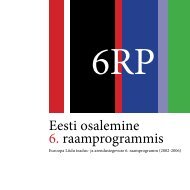Reactive Systems: Modelling, Specification and Verification - Cs.ioc.ee
Reactive Systems: Modelling, Specification and Verification - Cs.ioc.ee
Reactive Systems: Modelling, Specification and Verification - Cs.ioc.ee
You also want an ePaper? Increase the reach of your titles
YUMPU automatically turns print PDFs into web optimized ePapers that Google loves.
3.3. STRONG BISIMILARITY 49<br />
Theorem 3.1 For all LTSs, the relation ∼ is<br />
1. an equivalence relation,<br />
2. the largest strong bisimulation, <strong>and</strong><br />
3. satisfies the following property:<br />
s1 ∼ s2 iff for each action α,<br />
- if s1 α → s ′ 1 , then there is a transition s2 α → s ′ 2 such that s′ 1 ∼ s′ 2 ;<br />
- if s2 α → s ′ 2 , then there is a transition s1 α → s ′ 1 such that s′ 1 ∼ s′ 2 .<br />
Proof: Consider an LTS (Proc, Act, { α →| α ∈ Act}). We prove each of the statements<br />
in turn.<br />
1. In order to show that ∼ is an equivalence relation over the set of states Proc,<br />
we n<strong>ee</strong>d to argue that it is reflexive, symmetric <strong>and</strong> transitive. (S<strong>ee</strong> Definition<br />
3.1.)<br />
To prove that ∼ is reflexive, it suffices only to provide a bisimulation that<br />
contains the pair (s, s), for each state s ∈ Proc. It is not hard to s<strong>ee</strong> that the<br />
identity relation<br />
I = {(s, s) | s ∈ Proc}<br />
is such a relation.<br />
We now show that ∼ is symmetric. Assume, to this end, that s1 ∼ s2 for<br />
some states s1 <strong>and</strong> s2 contained in Proc. We claim that s2 ∼ s1 also holds.<br />
To prove this claim, recall that, since s1 ∼ s2, there is a bisimulation R that<br />
contains the pair of states (s1, s2). Consider now the relation<br />
R −1 = {(s ′ , s) | (s, s ′ ) ∈ R} .<br />
You should now be able to convince yourselves that the pair (s2, s1) is contained<br />
in R −1 , <strong>and</strong> that this relation is ind<strong>ee</strong>d a bisimulation. Therefore<br />
s2 ∼ s1, as claimed.<br />
We are therefore left to argue that ∼ is transitive. Assume, to this end, that<br />
s1 ∼ s2 <strong>and</strong> s2 ∼ s3 for some states s1, s2 <strong>and</strong> s3 contained in Proc. We<br />
claim that s1 ∼ s3 also holds. To prove this, recall that, since s1 ∼ s2 <strong>and</strong><br />
s2 ∼ s3, there are two bisimulations R <strong>and</strong> R ′ that contain the pairs of states<br />
(s1, s2) <strong>and</strong> (s2, s3), respectively. Consider now the relation<br />
S = {(s ′ 1, s ′ 3) | (s ′ 1, s ′ 2) ∈ R <strong>and</strong> (s ′ 2, s ′ 3) ∈ R ′ , for some s ′ 2} .
















